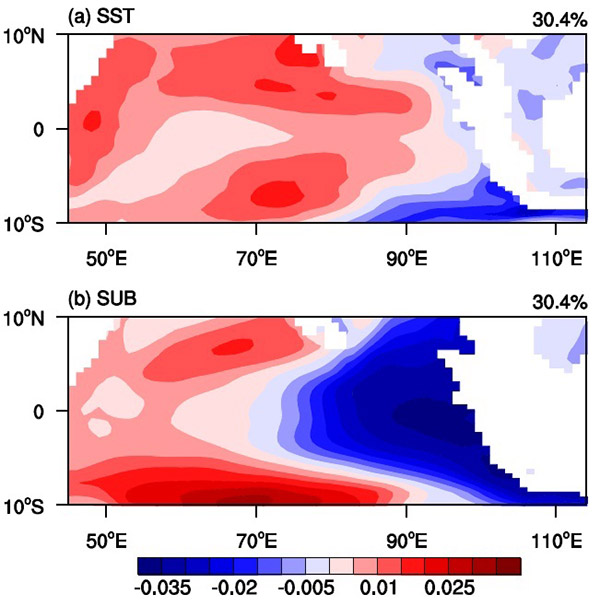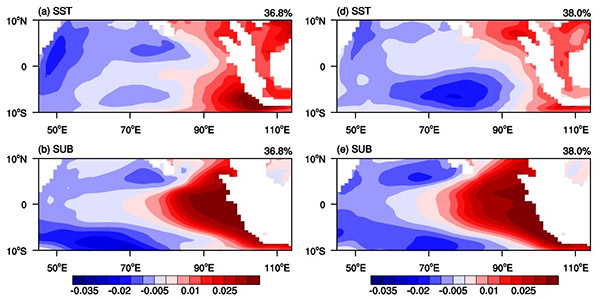State Key Laboratory of Numerical Modeling for Atmospheric Sciences and
Geophysical Fluid Dynamics (LASG)
Institute of Atmospheric Physics, Chinese Academy of Sciences

Vol. 3/No.3 August 2017
Measuring and modelling the impact of a severe drought on terrestrial ecosystem CO2 and water fluxes in a subtropical forest
Highlights:
Respiration decreased along with GPP when temperatures exceeded 32 ºC and soil moisture was below 0.14 m3 m–3
The subtropical forest ecosystem turned to a net source of carbon after two months of consecutively dry days
The model captured the water vapor flux variability quite well but overestimated net carbon fluxes during the summer drought
A severe drought occurred in central and southern China in the summer of 2013. The precipitation dropped to less than 25% of the long-term average, and temperatures were abnormally high for more than two monthswith return periods of 125-year and 301-year respectively, which induced significant changes in the terrestrial eco-hydrological cycle.
Recently, scientists from CAS institute, XIE Zhenghui and WANG Linying in LASG/Institute of Atmospheric Physics usedground-based observations from a flux tower and simulations by the land surface model CLM4.5 with the prognostic carbon and nitrogen dynamics to investigate the influence of the 2013 summer drought on ecosystem CO2 and water fluxes in southern China. They found that plant photosynthesis was clearly restricted in July and August (Figure 1) and reached the recorded minimums. There was an exponential relationship between ecosystem respiration(Reco) and temperatureswhen soil water content was plentiful, but Reco decreased along with GPP under dry soil conditions (< 0.14 m3 m–3, Figure 2). The ecosystem even switched toa net source of carbonin late August (Figure 1). The model captured the variations in water vapor fluxes well, with correlation coefficients r > 0.88,but overestimated net ecosystem CO2 exchange (NEE) because it did not adequately represent carbon fluxes responses to water stress and failed to capture the nonlinear relationship between GPP and Recoduring the drought period. The long-term simulation suggested that water availability severely limited carbon sequestration, and both the underlying water use efficiency (uWUE) and inherent WUE (IWUE) reached their maximum values.

Figure1.Time series of daily mean (a) net ecosystem CO2 exchange (NEE), (b) ecosystem respiration (Reco), and (c) gross primary production (GPP) during the 2013 growing season for the in situ observations (OBS), the CLM-CMA and CLM-NX simulations, and the climatological simulation (Climatology, the blue band indicates one standard deviation from the historical data).

Figure 2. The effect of daily air temperature on ecosystem respiration (Reco) under different soil moisture conditions from April to October for (a) the in situ observations (OBS) and (b) the CLM-NX simulation (CLM4.5).
The paper has been published in Journal of Geophysical Research: Biogeosciences in 2016.
References:
Xie Z., L. Wang, B. Jia, et al (2016). Measuring and modelling the impact of a severe drought on terrestrial ecosystem CO2 and water fluxes in a subtropical forest, J. Geophys. Res. Biogeosciences, 121, doi: 10.1002/2016JG003437.
http://onlinelibrary.wiley.com/doi/10.1002/2016JG003437/abstract
Contact: XIE Zhenghui,zxie@lasg.iap.ac.cn
E-mail: lasg_newsletter@lasg.iap.ac.cn
Editors: Chuanyi Wang (wangcy@lasg.iap.ac.cn), Kangjun Chen(ckj@lasg.iap.ac.cn)